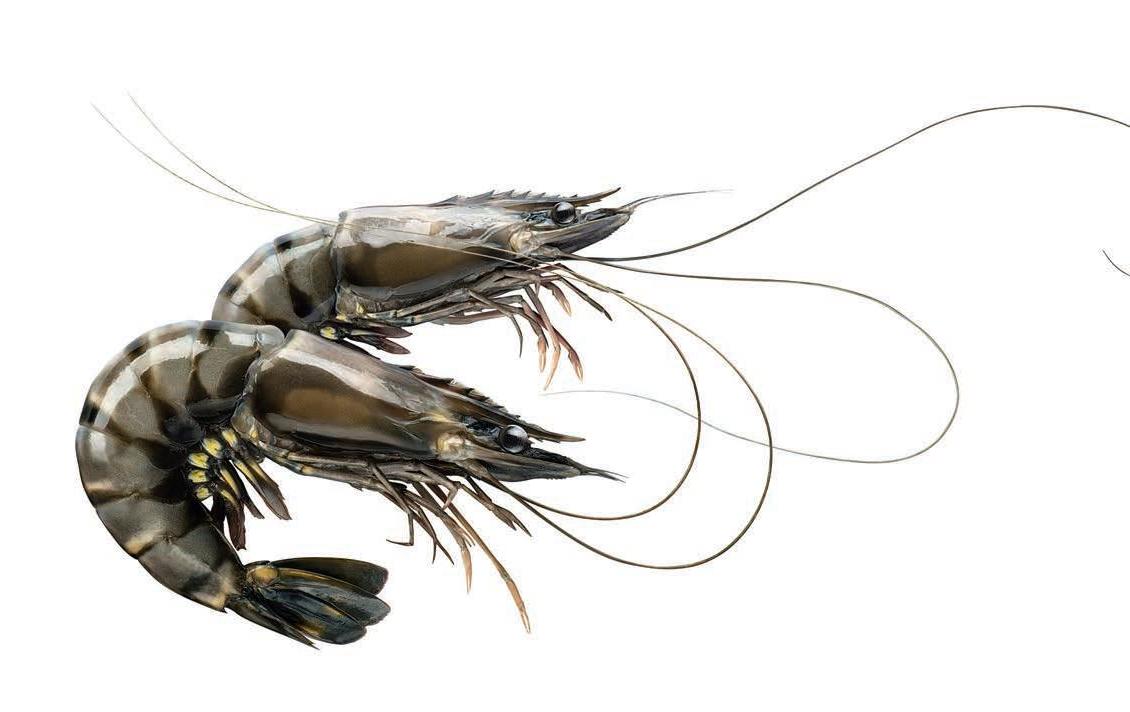
6 minute read
Shellfi sh
BY NICKI HOLMYARD
Better together
Combining different species in one site is an old idea, given a new twist
Anewly-released report by EUMOFA, the European Market Observatory for Fisheries and Aquaculture Products, looks in part at the past, present and future of integrated mul� -trophic aquaculture (IMTA) in the “Blue Economy”.
In IMTA systems, species from diff erent trophic levels are raised in proximity to one another. The waste stream from fed species, such as fi sh, become nutrients for others. For example, fi lter feeders like mussels, clams, cockles and oysters, take up the fi ne par� culate material, while plants like kelps take up the dissolved inorganic nutrients. In addi� on, deposit-feeding species such as cucumbers and sea urchins can be raised directly underneath a farm, to take up larger par� culate organic material.
As a result, IMTA reduces the ecological impacts of fi sh farming opera� ons, by ac� ng as an environmental remediator. It can also improve social percep� ons of aquaculture, and provide fi nancial benefi ts for producers through product diversifi ca� on, faster produc� on cycles, and price premiums on IMTA products.
Although the concept of IMTA has been around for millennia, the phrase “integrated mul� -trophic aquaculture” was fi rst introduced in 2004 by its Canadian champions Dr Thierry Chopin and Dr Shawn

Below Left: Tiger prawns Opposite: Sugar kelp; mussels; cockles; sea cucumber Robinson. According to Dr Robinson, IMTA is “a reasonably complicated way of just saying ‘mixed farming’.”
The pair were awarded the 2009 Research Award of Excellence of the Aquaculture Associa� on of Canada, which recognises excep� onal, innova� ve research contribu� on and commitment that has a signifi cant impact on aquaculture industry development in Canada.
The EUMOFA report tells us that IMTA has progressed from the land-based co-culture of fi sh and rice in China, which can be seen in surviving clay models of rice fi elds and aqua� c life da� ng back 2,000 years to the late Han period, to the concept of holis� c aquaculture introduced in the 1970s, and the more sophis� cated concepts of today.
References to the use of diff erent trophic levels in aquaculture for remedia� on of nutrient overloads or addi� onal produc� vity date from the early 1970s, and IMTA was a reality in China in the 1980s.
China is the world’s largest producer and consumer of fi sh, shellfi sh and seaweeds, and is o� en used as a model for the applica� on of IMTA. The country has more than 50 major bay systems, and 10 million hectares of coastal waters, 1.3 million hectares of which are suitable for inshore mariculture and IMTA. Sanggou Bay is the most important and best known example of integrated mul� -trophic aquaculture.
IMTA exists in three forms in China: incidental, transi� onal and engineered. Incidental is the most common form, and occurs when extrac� ve species and fed species are farmed in the same semi-enclosed bays, as a coincidence of aquaculture expansion, leading to the natural assimila� on of waste. Transi� onal systems are set up inten� onally with species from diff erent trophic levels to supplement overall farm produc� on, while engineered

systems use intensive techniques, which are currently being experimented with in China, and include a programme of marine ranching using ar� fi cial reefs.
The predominant farming system in China’s coastal bays is suspended mariculture, which began with seaweed in the 1950s, added scallops in the 1960s, and expanded to large-scale suspended fi sh cage culture in the 1980s.
In Sanggou Bay, which covers an area measuring 163 km2, shrimp farms are located along the inner coast in � dal fl ats, giving way to fi nfi sh in cages in the inner bay, scallops and oysters grown on longlines in the mid-bay, and other bivalves farmed in combina� on with macroalgae in the outer-mid-bay. At the mouth of the bay, sugar kelp (Saccharina la� ssima) grows alongside abalone, which feed on the seaweed. In turn, the kelp takes up nutrients released from the abalone, in a circular and mutually benefi cial system. Other seaweeds with diff erent seasons are also grown.
Each year, aquaculture farmers in Sanggou Bay produce around 120,000 tonnes of oysters, 84,500 tonnes dried weight of sugar kelp, 10,000 tonnes of scallops, 2,000 tonnes of abalone, 100 tonnes of fi nfi sh and 100 tonnes of sea cucumbers.
According to the EUMOFA report, the market for seaweed in China changed from being 8090% a commodity market for alginates in the early 1990s, to around 60% in the mid-2000s. By 2018, 60–70% of farmed seaweed output was being used for food and animal feed, and the remainder for abalone and sea cucumbers.
Seaweeds are touted as the IMTA species par excellence, due to their ability to absorb large amounts of dissolved nutrients and grow faster than land crops. In Europe, the classic IMTA combina� on of salmon, mussels and macroalgae was fi rst studied for its ability to capture waste nutrients from fi sh farming in Norway.
The EU has since funded many projects on diff erent aspects of IMTA under Horizon 2020, the EU’s Framework R&D and Research & Innova� on Programmes, and Interreg. Projects include seaweed cul� va� on and valorisa� on, and integra� on of aquaculture with marine ac� vi� es such as wind farms.
However, despite encouraging results in terms of environmental and economic benefi ts, IMTA has failed to take off on a commercial scale, although it has garnered a growing interest in farming seaweed as a stand-alone crop.
Barriers to developing IMTA as a commercial concept include diffi cul� es in encouraging established salmon farms and off shore wind farms to integrate the types of IMTA available. The report suggests that a new direc� on needs to be taken – one that moves away from the classic model of fi nfi sh cage at the top, bivalve lines or cages surrounding and below them, and seaweed on the sea bed.
The exis� ng model works well on a research scale and in modelling, but has not been shown to be robust enough in real life, for industry to invest and take on the addi� onal opera� onal complexi� es needed.
In 2018, a European Parliament report provided the star� ng point for policy changes and ac� ons to encourage aquaculture innova� ons such as IMTA, by specifi cally called for IMTA pilot projects. This report agreed with the Food from the Oceans scien� fi c report, which found that the only way to obtain signifi cantly more food and biomass from the ocean in a short period of � me, is to harvest organisms at the bo� om of the food chain, such as macroalgae and bivalve molluscs.
While condi� ons are not yet fully in place in Europe for the widescale adop� on of IMTA, commercial and consumer interest appears to be growing, alongside that of policy makers. Perhaps these combined forces may pave the way for some exci� ng developments in future.
See EUMOFA’s Blue Bioeconomy Report at bit.ly/2Lh9oAM. FF
















